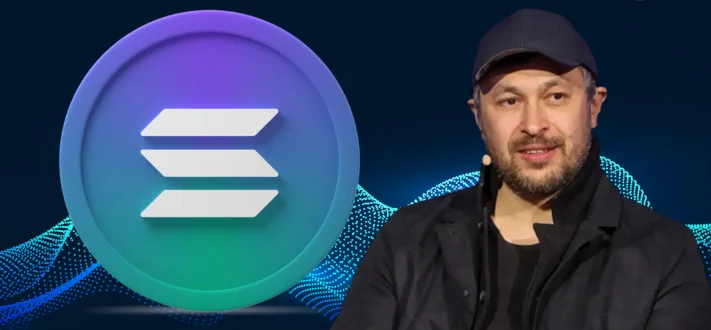According to Anatoly Yakovenko, Solana possesses three advantages: transaction efficiency, infrastructural focus, and scalability.

In a recent interview, Anatoly Yakovenko, the founder of Solana, discussed the distinctive position that this ecosystem occupies in the blockchain landscape. He contrasted its implementation with other Layer 1 blockchain systems and L2 scalability solutions.
He has previously expressed concerns regarding the Ethereum ecosystem‘s sustainability in the absence of Base, a Layer 2 solution. This inquiry is prompted by the metrics of growth that Base has demonstrated, specifically in the areas of user activities and transaction volumes.
Anatoly Yakovenko of Solana: Achieving L1 Scalability Is Crucial, Not L2 Solutions
The Solana ecosystem’s distinctive position within the blockchain landscape was underscored by Anatoly Yakovenko, the company’s founder. He contrasted its methodology with that of other Layer 1 blockchains and Layer 2 scalability solutions.
The podcast in which he was a guest was a sort of follow-up to his previous statements, in which he questioned the resilience of the Ethereum ecosystem in the absence of contributions from Base, a Layer 2 solution. This was particularly relevant in light of Base’s remarkable growth metrics in user activity and transaction volumes.
“In my view, Solana has three advantages: transaction efficiency, infrastructural focus, and scalability,” Yakovenko elaborated. Naturally, he is also cognizant of the obstacles that Solana faces in a world where blockchain technology continues to develop and platforms continue to expand.
Anatoly Yakovenko underscored the distinctive architecture of Solana, which is intended to facilitate transaction validation for all users. Solana differs from conventional finance in that it enables individuals to establish a validator and submit transactions directly, thereby eliminating financial intermediaries.
Yakovenko observed that it is challenging for conventional finance to replicate this degree of decentralization. While this functionality is present, he acknowledged that deploying it effectively remains a challenge.
New validators encounter substantial obstacles, such as the difficulty of locating appropriate peers for transaction ordering. It is also challenging to accumulate a sufficient number of stakes to exert influence over the network. Yakovenko is of the opinion that Solana’s future is contingent upon consistent network optimization.
He anticipates technical enhancements that encompass increased bandwidth, reduced latency, and multiple concurrent leaders per transaction slot. These modifications, according to him, could potentially alleviate economic obstacles and facilitate the entry of new validators into the market.
Solana has the potential to cultivate a more competitive and healthier ecosystem by minimizing constraints. Ultimately, this would result in a more decentralized network.
Yakovenko regards Solana’s journey toward decentralization as an engineering challenge that necessitates iterative optimizations. Solana endeavors to attain equitable and efficient transaction processing through these endeavors.
Emphasizing Solana’s Advantages Over Ethereum and L2s
Anatoly Yakovenko contrasted Solana with Ethereum and a variety of L2 solutions, underscoring the trade-offs between Layer 1 and Layer 2. Centralized sequencers are frequently implemented in L2 solutions to facilitate low-latency transaction ordering.
Nevertheless, Yakovenko observed that these can result in the same congestion issues as those observed on Layer 1 circuits. Although L2s are frequently perceived as temporary solutions to congestion, they encounter scaling constraints when utilized by numerous applications or markets.
He emphasized that Solana’s strategy is to establish a Layer 1 chain that is sufficiently robust to accommodate high throughput without the necessity of L2 solutions. Yakovenko also emphasizes the importance of synchronous composability, which enables the interaction of multiple applications in real-time on a single chain. He is of the opinion that this is indispensable for DeFi. In his opinion, the scalability of monolithic chains or application-specific L2s is restricted by their inability to support this level of composability.
The final competitive advantage of Solana, as per Anatoly Yakovenko, is precisely its complete dedication to synchronous composability at scale, which distinguishes it from Ethereum and L2 chains. Nevertheless, some analysts, including Peter Brandt, have stated that Solana is currently achieving new highs, whereas Ethereum is encountering an overhead resistance.
Yakovenko’s primary message is that Solana’s advantage lies in execution. The development of Solana is still centered on the perfection of its L1, despite the fact that Ethereum is expanding through L2s. He acknowledges that a blockchain will eventually develop features similar to those of Solana and offer faster iterations. However, the rate at which Solana is advancing currently positions it significantly ahead of its competitors.
This fundamental aspect of Solana’s potential, according to Anatoly Yakovenko, is contingent upon the optimization of its infrastructure to facilitate more transparent, equitable transaction processing in order to achieve a genuinely decentralized future. According to him, this position establishes Solana as one of the most prominent blockchains for the foreseeable future.
